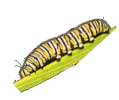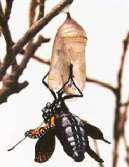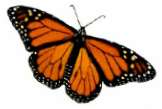The monarch starts life as an egg laid by the adult female on a leaf of the common milkweed plant, Asclepias syriaca. It is about the size of the head of a pin. When the egg hatches 3 to 12 days later, the tiny yellow-, white-, and black-striped worm-like larva, or caterpillar, has eight pairs of stubby legs for crawling about, and mouth parts designed for chewing leaves, which it does, voraciously. But only the leaves of the milkweed; no other plant will do. Now the milkweed has a white, sticky sap that is highly toxic to other animals, but does not affect the caterpillar at all, except to make his body, in turn, highly toxic to predators like birds that might like to eat the caterpillar for breakfast. And the birds, being no bird-brains, know to leave him alone.
As the caterpillar eats and eats, it grows. Soon it gets too large for its skin, so the skin splits and out crawls the caterpillar with a new and larger skin with room to grow. For about two weeks this is what the caterpillar does: eats leaves, grows, sheds its skin, eats more leaves, grows more, sheds its skin. It will do this five times.



Finally it stops eating, finds a protected spot, hangs upside-down, spins a silk attachment, and sheds its skin one more time. But this time what emerges from the old skin is not a larger caterpillar, but a compact package with no legs and no eyes, and no visible body parts, called a pupa, encased in a chrysalis. It is not multi-colored like the caterpillar, but is bright green with golden-yellow spots.
No further movement is observed, but inside there is much movement. The heart still beats, but the rest of the internal organs resemble green jelly, as the entire mass reshapes itself into a completely different creature. The green color darkens, turns brown. To an uninformed observer, the package may appear dead. But gradually the color modifies as the chrysalis turns clear, and orange and black areas can be seen, the colors of the adult butterfly.
Finally, after about two weeks, the chrysalis splits open, and an adult butterfly emerges. It has six long legs, a mouth that is a long coiled-tube proboscis used for reaching into flowers to drink nectar, and two pairs of shriveled wings that rapidly expand as fluid from the body is pumped into their veins. As they expand, the butterfly slowly fans them back and forth with newly-acquired flight muscles until they are dry, so that the fully-extended wings are stiff, ready for flight.
Soon the butterfly flits off into the sky, and may be found in someone's flower garden, drinking nectar with its uncoiled proboscis, or flying overhead looking for a mate to start the whole cycle all over again.